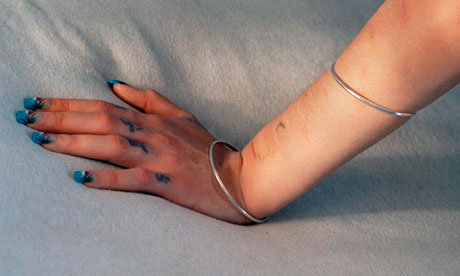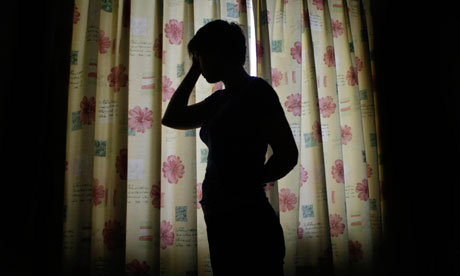When they assessed her case, British immigration officials knew that Katya, a vulnerable 18-year-old from Moldova, had been trafficked and forced into
prostitution, but ruled that she would face no real danger if she was sent back.
Days after her removal from the UK, her traffickers tracked her down to the Moldovan village where she had grown up. She was gang-raped, strung up by a rope from a tree, and forced to dig her own grave. One of her front teeth was pulled out with a pair of pliers. Shortly afterwards she was re-trafficked, first to Israel and later back to the UK.
The Home Office decision last week to pay her substantial damages has raised serious questions about the way Britain treats trafficked women. The unprecedented case also opens the possibility that other individuals who have been removed from this country and subsequently found themselves exposed to danger in their home country, could attempt to sue the Home Office for damages. The Moldovan woman was first kidnapped by traffickers when she was 14, repeatedly sold on to pimps and other traffickers, and forced to work as a prostitute for seven years in Italy, Turkey, Hungary, Romania, Israel and the UK. She told the Guardian that British police need to do much more to protect women like her and to prevent others from being trafficked into prostitution.
"Just look around you - see how many girls there are like me. They are coming all the time. I see them every day - in tube stations, all made up, early in the morning. Maybe for you it is difficult to see them, but I see them," said Katya (not her real name), in an interview in her solicitor's office. "I think the police should work better to stop this. Why don't you shut down saunas and brothels? Then there would be no prostitutes, no pimps."
The exhaustive account that Katya has given in court documents, explaining how she was targeted, captured and intimidated, reveals the sophisticated methods employed by gangs trafficking vulnerable women from eastern Europe, Africa and the far east. It also reveals the danger that these women are often exposed to when the British immigration service opts to remove them.
Experienced staff at the
Poppy Project, which provides specialist support for trafficking victims and which last week learned it was losing its government funding, described her story as among the most disturbing they have encountered. Katya has been diagnosed with post-traumatic stress disorder, but finds therapy sessions too painful to engage with.
She was living with her mother in Moldova when two older men invited her and a friend to a birthday picnic in a nearby forest. Both girls were knocked unconscious, driven to Romania, blindfolded, taken across a river in an inflatable dinghy to somewhere in Hungary, dressed in dark clothes and made to walk through the forest across the border during the night, passing through Slovenia and arriving eventually in Italy.
They were sold on to two separate men. Katya worked first in a flat in Rimini and then on the streets of Milan. After some months, she managed to escape and was sheltered for a while in the Moldovan embassy there, when she discovered she was pregnant.
She chose to return to her family in Moldova to have the child, but her traffickers found her, beat and raped her brother and killed the family dog as punishment for her decision to tell Italian police what happened to her. She discovered that the friend she had been kidnapped with had been murdered by traffickers in Israel who had drugged her and thrown her off a seven-storey building. These experiences terrified her so much that for years she avoided doing anything that might upset her traffickers in case they acted on their threats to hurt her family.
After she gave birth, and sent her daughter to live in relative safety with an aunt, Katya was sent to Turkey to work in a nightclub. She was later smuggled in a lorry to work in a London brothel. During her time working as a prostitute, she was given no money for her work and was not allowed to go anywhere unaccompanied in case she tried to escape. Her clients in London rarely asked about the conditions in which she was working. "The clients, they're drunk, and just come and say, 'Give me this, that'. No one asks: 'How are you?'. Some of them asked, 'Why do you do this job?', but I wouldn't answer," she said, explaining that she was afraid that if she appealed to them for help, they might turn out to be friends with the trafficker.
She and the other women - mainly eastern European, none of them British - never talked of their circumstances among themselves. "I didn't know if the other girls were friends of the trafficker. It was dangerous to speak to the clients or the other girls. There were speakers in the flat where we lived. We didn't talk about anything. Sometimes we were locked up for weeks and weeks, not going out."
The brothel, in Harrow, north-west London, was raided a few weeks after she arrived. She was arrested, but she did not reveal the full details of her enslavement to the police because the Kosovan Albanian man who had bought her told her that her family would be in danger if she said anything.
Because officials did not realise Katya had been intimidated by her trafficker, they allowed him to visit her nine times when she was in detention, visits he used to intimidate her further. Although they recognised that she had been trafficked, immigration officials decided to remove her to Moldova, judging that there was no real risk to her safety. A few days after she returned home, her traffickers found her.
"They took me to a forest and I was beaten and raped. Then they made a noose out of rope and told me to dig my own grave as I was going to be killed," Katya's court statement reads. "They tied the noose around my neck and let me hang before cutting the branch off the tree. I really believed I was going to die. They then drove me to a house where many men were staying. They were all very drunk and took turns to rape me. When I tried to resist, one man physically restrained me and pulled my front tooth out using pliers."
The attack ended only when her trafficker told the men they needed to stop as Katya was to be sold in Israel. "I think maybe they did not kill me because I was more valuable alive," her statement reads. Katya, now 26, is thin and pale, but dentists have replaced her tooth, and her other scars are well hidden. "I didn't have too many scars or injuries as the traffickers wanted to keep me looking pretty," she said. After working in Tel Aviv for a while, Katya again escaped before being trafficked to work in a central London flat, where her pimps sold her for £150 an hour; again, she received no money. In 2007 she was detained for a second time by immigration officials, who considered returning her to Moldova, before finally granting her refugee status.
Katya has been interviewed by medical and trafficking experts in preparation for the trial, all of whom found her account credible. Her legal team argued immigration solicitors should have investigated evidence that she was a victim of trafficking and that their decision to return her to Moldova, where she ran the risk of retribution and retrafficking, was a violation of her rights under article 3 (the right to freedom from torture and inhumane and degrading treatment) and article 4 (the right to freedom from slavery and servitude) of the European convention on human rights. Paul Holmes, the now retired former head of the Metropolitan police's vice unit, CO14, said in a pre-trial statement that there was already much evidence by 2003 that should have led immigration officials to identify her as a trafficking victim. He said there was "friction" at that time between the immigration service's desire to remove "illegal entrants" to the country, and his department's desire to interview potential victims and get them to testify against traffickers.
"Our doubt about the effectiveness of prompt removal was exacerbated by the fact that our intelligence-gathering and operational activities had highlighted the fact that in some cases, victims that had been removed were subjected to retrafficking and were being discovered for a second time in London brothels or elsewhere within weeks of their original removal," he said.
Katya's case was due to open last week at the high court in London, but Home Office lawyers agreed to pay substantial, undisclosed damages the day before the scheduled start of the case.
Her solicitor Harriet Wistrich, of legal firm Birnberg Peirce, said she hoped the case would highlight the dangers of unlawful removal and could prompt other claims. Wistrich said she believed the case, which has been two years in preparation, might also educate people about the reality of trafficking of women from eastern Europe. "People don't believe it's happening on this scale. People don't want to believe it," she said.
There is no clear data to indicate how many trafficked women may be in England and Wales, but research for the Association of Chief Police Officers last year found clear evidence of 2,600 trafficked victims and of another 9,600 "vulnerable migrants" who might have been trafficked.
The Home Office says there have been improvements in the way immigration officials deal with trafficked women since 2003, and minister Damian Green said: "The UK has become a world leader in fighting trafficking and has a strong international reputation in this field."
But Sally Montier, of the Poppy Project, said the charity was still regularly helping women who were wrongly sent home and retrafficked. She warned that 21% of the women who came to the charity seeking help had already been sent home and retrafficked at least once.
"Worryingly, we are seeing an increase in women who have been identified as victims of trafficking but who are in the process of being removed," she said.
Last week's decision to award the Salvation Army the government contract to provide support to trafficked women would lead to the loss of the expertise built up by the Poppy Project over the last eight years, she said. "We are very worried that we will see more women who are not identified as having been trafficked, and who are consequently removed, so that they fall back into the cycle of trafficking and abuse."
Katya's traffickers have not been arrested and she is concerned they could now target her younger sister in Moldova. She plans to stay in the UK, has signed up for computer courses and English language classes, and is doing voluntary work. Recently she succeeded in bringing her daughter to live with her, but is troubled by the possibility that she could run into the people who forced her into prostitution in London.
She is sceptical about the likelihood that the Home Office decision could force officials to treat trafficking victims with more sensitivity: "If the government cared it would not be closing the Poppy Project. They don't care."
But she adds: "I'm not angry with the government. How can you be angry with the government? I'm angry with my life, the things that have happened."
Katya's story: trafficked to the UK, sent home to torture http://t.co/R8sa3Vo via @guardian













